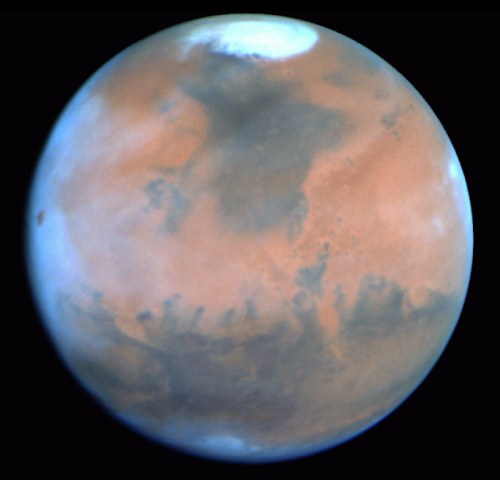
| Orbital Elements | ||
| Mean distance from Sun | 227,940,000 km | = 1.5237 astronomical units |
| Perihelion distance | 206,700,000 km | = 1.3817 astronomical units |
| Aphelion distance | 249,100,000 km | = 1.6651 astronomical units |
| Eccentricity of orbit | 0.0934 | |
| Inclination of orbit | 1.850° | relative to Earth's orbit |
| Period of orbit | 686.98 days | = 686:23:31:12 |
| Synodic period | 780 days | relative to Earth |
| Mean orbital speed | 24.13 km/s | |
| Minimum orbital speed | 21.97 km/s | |
| Maximum orbital speed | 26.50 km/s | |
| Physical Properties | ||
| Mean diameter | 6,780 km | = 0.532 Earth diameter |
| Polar radius | 3,376 km | |
| Equatorial radius | 3,397 km | |
| Oblateness | 1/193 | |
| Mass | 6.421 x 1023 kg | = 0.10745 Earth mass |
| Mean density | 3.94 gm/cm3 | |
| Rotational period | 1.02595675 days | = 24.622962 hours = 24:37:22 |
| Length of day | 1.0274907 days | = 24.6597768 hours = 24:39:35 |
| Inclination of axis | 25.19° | relative to the axis of its orbit |
| Gravity at surface | 3.72 m/s2 | |
| Escape speed | 5 km/s | from surface at equator |
| Visual geometric albedo | 0.15 | |
| Visual magnitude (Vo) | -2.9 | maximum, as seen from Earth |
| Mean surface temperature | -63°C | |
| Maximum surface temperature | 20°C | |
| Minimum surface temperature | -140°C | |
| Atmospheric pressure | 0.007 bar | varies with seasons by 25% |
| Atmosphere composition by volume | ||
| Carbon dioxide (CO2) | 95.32% | |
| Nitrogen (N2) | 2.7% | |
| Argon (Ar) | 1.6% | |
| Oxygen (O2) | 0.13% | |
| Carbon monoxide (CO) | 0.07% | |
| Water (H2O) | 0.03% | |
| Neon (Ne) | 0.00025% | |
| Krypton (Kr) | 0.00003% | |
| Xenon (Xe) | 0.000008% | |
| Ozone (O3) | 0.000003% | |
| Moons | |
| Two small moons: | |
| Phobos | |
| Deimos |
 To my Space and Science home page
for more about the Solar System
To my Space and Science home page
for more about the Solar System
Jeff Root
September 4, 2003